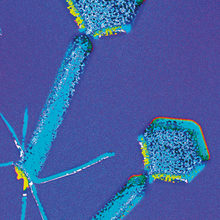Editorial
Issue: Future Tech
09 August 2016 article

Science is a broad church and the designation of scientific disciplines fascinates me. Four overarching categories map the sciences: formal science, social science, applied science and natural science. The life sciences, considered the study of any living organism, are a strand of the natural sciences, and microbiology, the study of micro-organisms, is one of more than 20 sub-branches found under the ‘life sciences’ umbrella. As technologies and scientific knowledge grew, the number of branches and sub-branches expanded in tandem and continues to today. The definition of each branch and sub-branch stakes a claim to a unique selling point that gives it an identity and a focus, but, nevertheless, with overlap.
Advances and tools from the study of microbiology underpin several of the branches of life sciences. Restriction enzymes and cloning technologies, cloning vectors and overexpression vectors, heat-stable DNA polymerases and DNA sequencing, and the polymerase chain reaction (PCR) are cornerstone tools of many other branches including biochemistry, molecular biology, genetics, genomics, immunology… The list goes on.
Mining microbes for molecular tools is an on-going process and sea-change technologies continue to emerge. The relative ease with which microbes can be manipulated has also enabled the development of new technologies that can be applied to the study of life sciences and present potential solutions to global problems. This issue celebrates some of these significant tools, techniques and technologies from microbes.
First, S. Andrea Gazze, Lewis Francis and Geertje van Keulen describe how exciting novel microbial properties and behaviours can be revealed by applying nanoscale analytical techniques, such as atomic force microscopy, to pure cultures and in situ ecosystems such as the soil.
One of the central themes of biology is that structure is linked to function. Niall Simpson, Neil T. Hunt and Paul A. Hoskisson’s article describes how true collaborations between microbiologists and physicists can lead to fascinating insight into biological systems, especially when applying exciting new techniques. They describe how fast, dynamic structure–function relationships can be studied using ultrafast two dimensional infrared spectroscopy (2D IR) that is uniquely sensitive to structural dynamics and is capable of extending the range of information available to microbiologists studying molecular interactions. This is followed by David Bhella’s fascinating article on the emerging technology of cryo-electron microscopy.
All organisms are exposed to parasites, and evolved a range of different immune mechanisms to defend themselves. Edze Westra describes how scientists have discovered that bacteria and archaea have a sophisticated adaptive immune system, known as CRISPR-Cas (clustered regularly interspaced short palindromic repeats). The insights gained about this system have led to several applications in industry to protect bacterial species against their viral parasites. In addition, CRISPR-Cas has been turned into a versatile genome editing method that has the potential to treat human genetic diseases.
I have written the last article on the growing global problem of antibiotic resistance. One approach to tackle this issue is to find alternatives to antibiotics used to combat pathogens. In this article I describe how the increasing understanding of bacteriophage and their lifecycles might offer an alternative to new antibiotic discovery.
Finally, Justin O’Grady has written a Comment article that highlights the need for a paradigm shift in diagnostics technology, to allow for the development of a rapid universal diagnostic that can detect any pathogen or resistance for the effective treatment of life-threatening infections. He describes how next-generation sequencing technology, particularly rapid nanopore sequencing and Oxford Nanopore Technologies’ MinION device, has the potential to drive this technology gear- shift forward by combining rapidity with comprehensiveness beyond simple microbial culture or PCR.
Microbiology has transformed the life sciences. Microbiologists and microbes continue to be at the forefront of new invention and innovation, and and are pioneering the technology of the future.
LAURA BOWATER
Editor
[email protected]
Image: P2 bacteriophages. Dr Harry Fisher, Visuals Unlimited/Science Photo Library..
